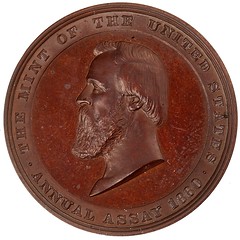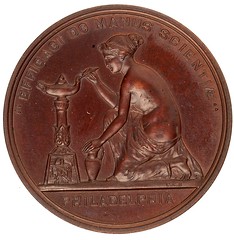
PREV ARTICLE
NEXT ARTICLE
FULL ISSUE
V25 2022 INDEX E-SYLUM ARCHIVE ON BRONZED COPPERScott Miller writes:
"Regarding Chester Sullivan's inquiry about the term bronzed copper, it refers to a copper medal that was treated with chemicals, such as a bronzing powder, to give a red or dark brown finish. Many medals struck prior to the late nineteenth century were copper. To quote from R. W. Julian's "Julian then described medals struck from about 1825 to 1891 as having a proof surface and ranging in color from a light red to a dark brown, sometimes referred to as mahogany finish. Medals from about 1891 to 1910 or a bit later have a dull surface, and are usually dark brown, and referred to as dark chocolate medals. My own experience is that dark brown medals are referred to as having either mahogany or chocolate brown finish without distinction. " Craig Sholley writes: "Bronzing is the artificial patination of copper and its alloys by chemical means. In some methods, the metal was coated with a water-paste of various salts and oxides, such as copper tartrate, red iron oxide, and bone ash and dried on a hot plate or over an open fire. Treatment was repeated as necessary to achieve the desired color. Other "paste methods" used extremely hazardous materials like cinnabar (mercury sulfide) and red lead. "Simpler aqueous methods were developed in the late 1600s using salt solutions made with water or vinegar. The vinegar solution of ammonium chloride and verdigris (copper carbonate, often with copper chloride and/or copper acetate) developed by the French was used by the US Mint and probably Boulton. However, there were a number of "bronzing powders" of various compositions available - just choose the one that provided the colors desired. "Coins and medals are bronzed post-strike since striking would break the oxide coat during striking. The coins or medals are heated, placed in a copper pan, and covered with boiling bronzing solution. Chemical reaction creates a brown oxide coat of various hues, depending on the chemicals used and their proportions, along with the length of time they are left in the solution. "Past authors such as Breen and Doty thought that planchets were coated with bronzing powder and the strike adhered it to the surface. I can only assume they thought this from the occasional piece seen with encrustations on the surface. However, the historical records clearly show that pieces were coated by the wet-chemical reaction noted above. Encrustations are the result of allowing the solution to evaporate from the surface of the medal or coin. Trying to "pound" what is essentially "dirt" onto the surface of a coin or medal obviously would not work. "Since the Myddelton tokens were struck by Boulton in 1796, they were likely bronzed by John Middlehurst, Boulton's bronzing specialist, who also did the Monneron tokens (see Sue Tungate, "Matthew Boulton and the Soho Mint," 2010)." Thanks, everyone! -Editor
To read the earlier E-Sylum article, see:
Wayne Homren, Editor The Numismatic Bibliomania Society is a non-profit organization promoting numismatic literature. See our web site at coinbooks.org. To submit items for publication in The E-Sylum, write to the Editor at this address: whomren@gmail.com To subscribe go to: https://my.binhost.com/lists/listinfo/esylum All Rights Reserved. NBS Home Page Contact the NBS webmaster 
|


